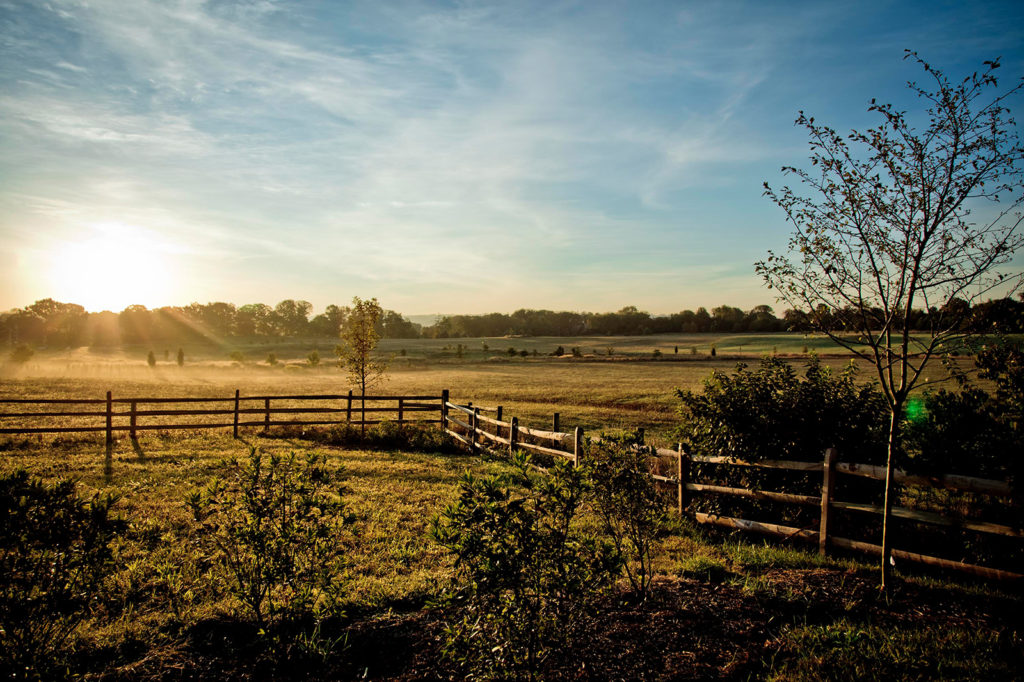Preserving Open Spaces
“Living in close proximity to all this open space is reassuring, peaceful and ‘restoreth the soul,’” Hugh Moulton tells me on a rainy Monday morning over a cup of hot coffee.
Hugh, who is a resident at The Hill at Whitemarsh, was one of the driving forces behind both developing the Continuing Care Retirement Community and preserving the surrounding 450 acres of land to prevent further development.
For hundreds of years—the original owner of the land purchased it in 1765—the property that eventually became the site of The Hill at Whitemarsh was open meadow and agricultural farming space. Eventually, the land was split between two families: George D. Widener, Jr. and his cousin, William McIntire Elkins. Elkins, who had built a mansion called “Briar Hill,” sold the estate in 1948 to use as a psychiatric clinic.
By the late 1990s, the developer had identified the “Briar Hill” property as the perfect spot to build the new Hill at Whitemarsh community. The developer needed more land to complete the full vision, however, and local community groups agreed to support the decision of developing a portion of Erdenheim Farm if they could also secure help to potentially preserve the rest of the Widener/Dixon land.
With full support of The Hill development team, a group of concerned citizens within the community decided to spring into action, forming The Whitemarsh Foundation. A not-for-profit group, they helped fundraise the money needed to buy two other portions of the farm from Dixon and preserve the open space from further development. Hugh served as the Foundation’s first Chairman and President.
“Preserving open space was always important to me,” says Hugh. “I used to spend summers up in Cape Cod with my family, exploring underdeveloped barrier beaches and enjoying the beauty of my surroundings. So when I had the opportunity to potentially save Erdenheim Farm and the surrounding land from development, it was a no-brainer.”
Part of the appeal, Hugh says, is that the agricultural use of the land dates back to the time of William Penn, evoking a sense of nostalgia and history for many of the local residents.
“Erdenheim Farm and all of the open space surrounding it is reminiscent of an earlier time when life was simpler,” says Hugh. “Even now, with the view from our home at The Hill At Whitemarsh, there is something reassuring and comforting in seeing that beautiful vista everyday.”
Whitemarsh Foundation spent years securing financial, community and legislative support from Harrisburg. Through a combination of hard work, dedication and good timing, by 2005 everything had started to fall into place, and The Hill was able to break ground. Within the next few years, the Foundation would also secure funding for the Sheep and Angus tracts to be saved from falling into the hands of developers. While the initial goals of the organization have been achieved—to save nearly 450 acres of land, in perpetuity, from one-acre housing—the Foundation continues to spread a message of access, awareness, advocacy and education when it comes to the preservation of agricultural spaces.
With the goal of preservation finally achieved, Kim Sheppard, the current President of Whitemarsh Foundation, has now set the Foundation’s sights beyond maintaining Erdenheim Farm in the same agricultural use since the days of William Penn and maintenance of the 14-acre Dixon Meadow Preserve for purposes of storm water management and use as a living laboratory for the study of agricultural life, ecological issues, sustainability and land stewardship. Currently, the Preserve offers recreation and education for its visitors, but the Foundation aims to expand the educational offerings and establish more creative collaborations with like-minded organizations.
“We are working in alliance with others to envision and execute an even stronger presence with expanded educational programs,” says Kim. “We are planning an outdoor painting class with Woodmere Museum and continue to coordinate with Whitemarsh Township, Morris Arboretum, William Jeanes Memorial Library, WVWA, The Hill at Whitemarsh and others for continued educational series.”
The Whitemarsh Foundation plays an important role in the surrounding community, educating people about the importance of open space and all that comes along with it.
“Our programs enrich the participants in varied ways, including birding, nature photography, flora and fauna exploration, journaling in nature, drone videography, butterfly repopulation and falconry exhibitions, with others to come as we continue to explore and grow the program,” said Kim.
Finding broad support for the Foundation and its mission has not been a problem, although the group is always looking for members of the community to get involved, both through donations and advocacy of the organization.
“It’s difficult for me to articulate why this Foundation was so important to me,” says Hugh. “But if we can’t make the world safe for plants and animals, what hope is there for us? And if that’s not enough, you really can’t beat the view.”
